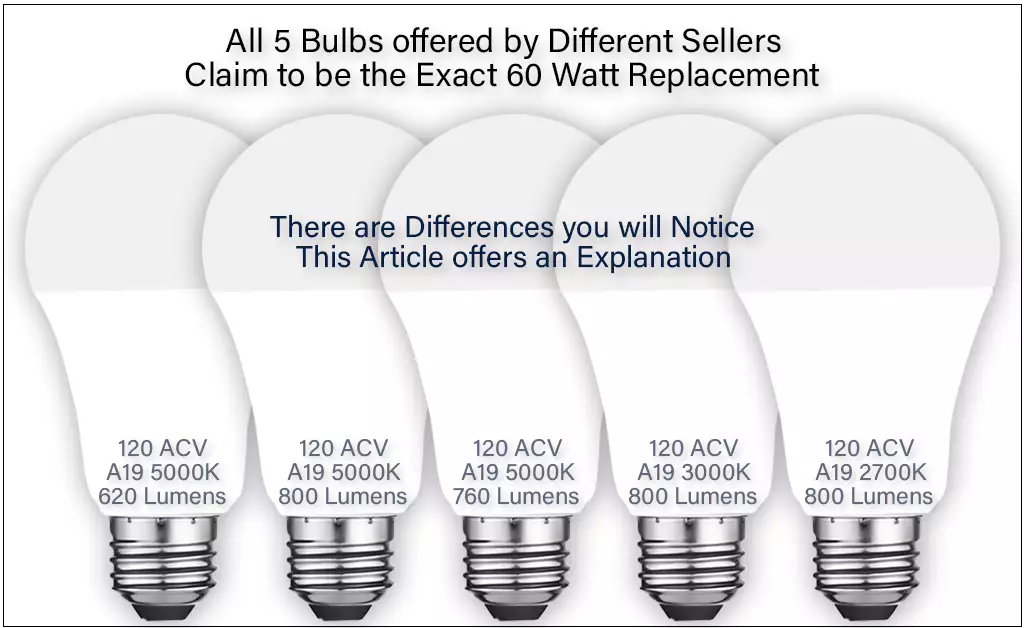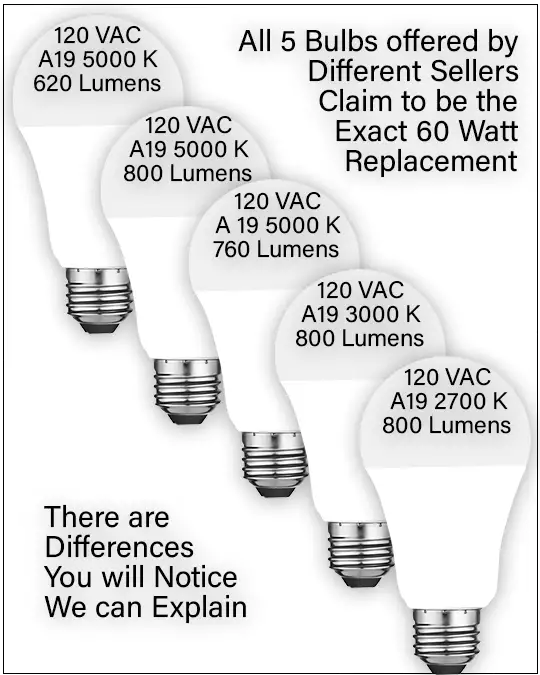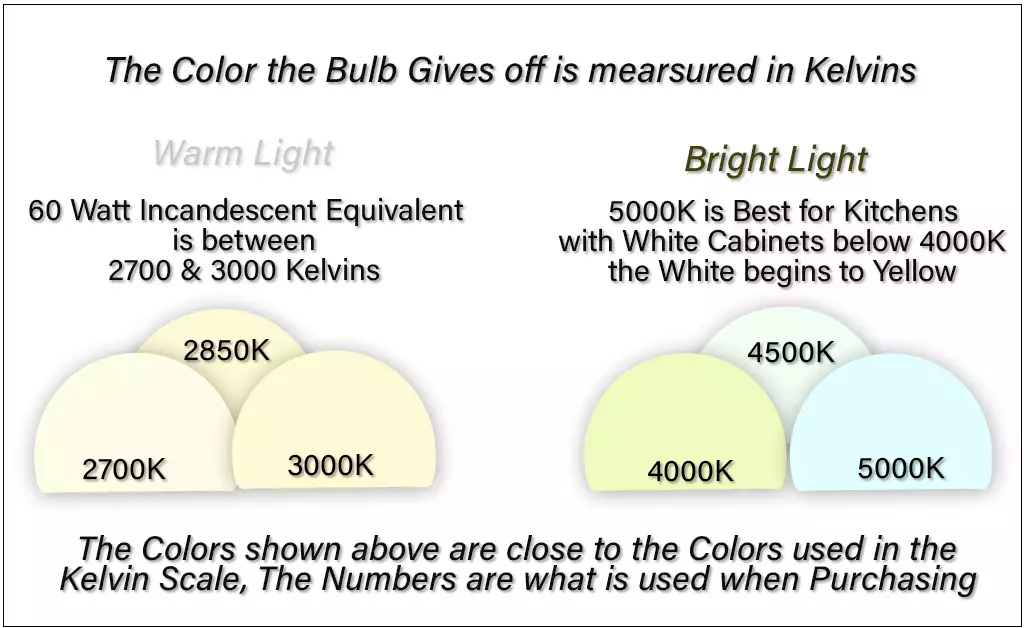

What are the Differences
Lighting Your Room with LED's
Most Everyone by Now has Some if Not all their Light Fixtures Operating with LED Bulbs. LED Bulbs last longer and Cost of Operation is 80% to 90% less than the Incandescent Bulbs.
LED Bulbs use Less Power to Operate, about 1/2 of a CFL (Compact Florescent Light), that we were all Buying in the Middle to late 80's through around 2010. General Electric stopped making CFL's in 2016.
Incandescent Bulbs have been fighting to stay alive since the first Initiative was introduced in 2007. But as of August 1, 2023 The Executive Branch of the US Government has Banned the sale of Incandescent & Halogen or any Bulbs that produces less than 45 Lumens per Watt.
Some People say they Hate them and others have Adjusted, most are OK with the LED Bulb. The Color the LED Bulb Produces is most Confusing.
Kelvins is the Color Produced
The Color is Measured in Kelvins, a variation in the Color Output could change the Color appearance of the Wall or Ceiling. Most don't want the Same color in the Bedroom as they have in the Kitchen or Bathroom.

- Bedrooms & Living Room - 2700 Kelvins, a calming Relaxing Tone. You could go 500 Kelvins higher or lower. Lower goes towards Red - Higher goes towards Yellow.
- Kitchen & Bathroom - 4000 Kelvins, Natural Light Tone. You could go 200 Kelvins higher or lower. Lower goes towards Yellow - Higher goes towards Whiter.
- Office, Garage or Work Shop - 5500 Kelvins, Bright Clear Tone. You could go 500 Kelvins higher or lower. Lower goes towards White - Higher goes towards Blue.
- Workplace, Workshop, Dental Office - 6500 Kelvins, Very Bright Alert Tone. You could go 500 Kelvins higher or lower Lower goes towards Blue White - Higher goes towards Darker Blue.
Lumens Describes the Brightness
Lumens is equal to the Amount of Light Produced. The Higher the Lumens the Brighter the Bulb. Some Packaging Equates the Brightness to Watts, an example is, a 40 Watt Equivalent to 450 Lumens.
Some Confuse Brightness with the Color of the Light produced because a Whiter Color appears to be Brighter.
Before the Days of LED's and CFL's we used Incandescent Bulbs, the only thing we needed to know was Watts. We already knew the amount of Light we would get from a 25, 40, 60, 75 or 100 Watt Bulb, it won't be long before we have the same Confidence with Lumens.
A 6 Watt LED is comparable to a 40 Watt Incandescent, a Bulb used for a Table Lamp or Coach Light Outside. Over the Life of the LED Bulb rated at 6 Watts you could save more than the cost of the Bulb.
Don't buy LED Bulbs just because it's Convenient at a Club Store or Big Box Store. Become Familiar with the Lumens and Kelvins, Purchase just 1 Bulb to learn the Colors and Brightness, Become an Expert.
Brightness Comparisons - Watts vs Lumens
| Type/ Lumens |
450 | 800 | 1000 | 1600 | 2600 |
|---|---|---|---|---|---|
| LED | 6 w | 9-10 w | 13 w | 18 w | 24 w |
| Incan | 40 w | 60 w | 75 w | 100 w | 150 w |
| CFL | 9 w | 14 w | 19 w | 23 w | 40 w |
| Halo | 29 w | 43 w | 53 w | 72 w | 150 w |
What is a Watt
A Watt is the Amount of Electrical Energy used by an Electrical Devise, (Light Bulb) per second. 1 Watt is equal to 1 Ampere (current), under the Pressure of 1 Volt. 1 Watt is the Power of a Joule of Energy per second.
1 Watt is not much energy, Old Style Light Bulbs rated at 60 Watts have been replaced by the LED Bulbs using less than 10 Watts. Your Electric Provider calculates the Watts used by all the Lights and Appliances for a month. Your Electric Bill will show the KWH (Kilo Watt Hour) used in a month, that number is multiplied by the rate per KWH plus various other fees to show the Amount you will pay.
There are many ways t reduce your monthly Electric Bill, Sometimes it is a simple as turning off Lights when you leave a room or raise the Temperature setting on the AC 1 degree.
Led Facts & History
The Discovery of the LED Light is credited to Nick Holonyak Jr, an Engineer at General Electric 1962 when he demonstrated the Semiconductor Diode emitting visual light. Nick Holonyak Jr was also an Educator born in 1928, died in September 2022. The first LED was small and did not have any Practical use at the time.
Various Engineers and Companies experimented with Diodes and Semi conductors trying to produce a useful LED Light. Monsanto was the first Company to mass produce LED Light Bulbs.
When Calculating the expected life of a LED Bulb, the Heat that the Bulb Generates must be Dissipated. Inefficient Heat Dissipation will decrease the expected life. A LED Bulbs life is considered over when it's light output has decreased by 30%.
Some may think because the LED Bulb is so inexpensive to Operate you can just leave it on all day. That is not the case, we have made a calculation for 6 Can Lights on for 4 hours a day for 1 month.
The light bulbs are BR30 rated at 8.3 watts about 500 Lumens and 5000K Color Temperature. The average Arizona electric cost per kilowatt hour is 12.3 cents.
6 Bulbs @ 8.3 Watts each = 49.8 Watts Total
Multiply 49.8 X's 4 hours expected use = 199.2 Watts in 4 hours
Divide by 1000 this equals .1992 kWh
Multiply .1992 by $12.3/kWh = $2.45
$2.45/dayX's30days=$73.50/month
Comment Below
Like this Article, you can give us a Thumbs just click on the Icon. It's anonymous and we will Thank You.

“To Invent, you need a good imagination and a pile of junk”
Thomas Edison
© Copyright 2023 YPRemodel.com. All rights Reserved. This material may not be Published, Broadcast, Rewritten or Redistributed without written Permission.
